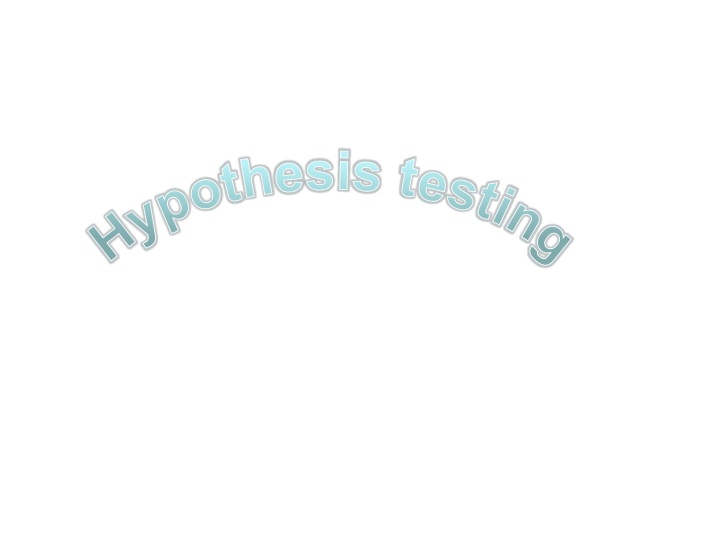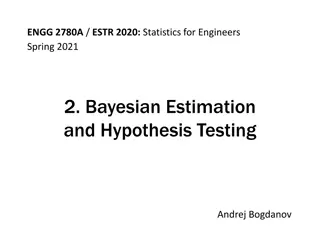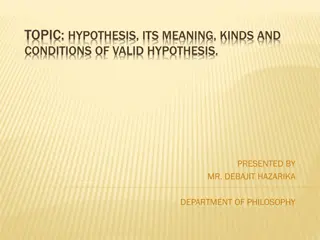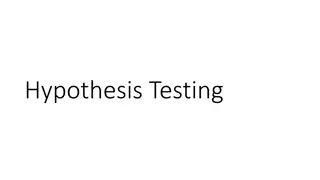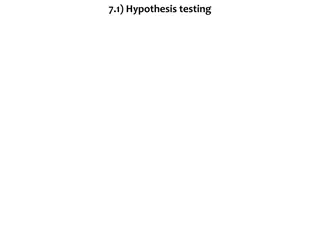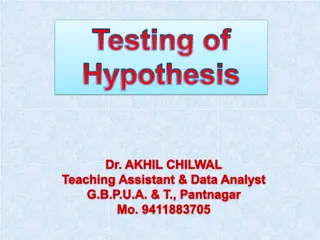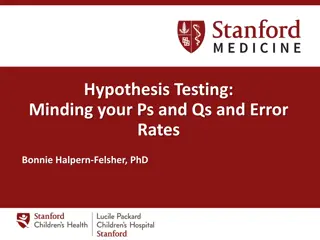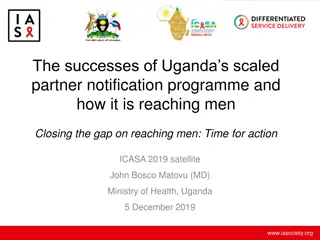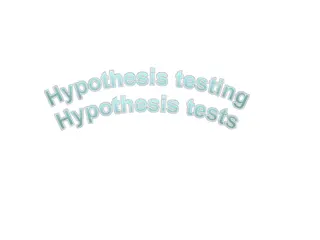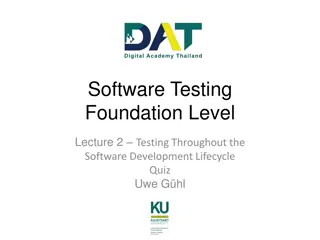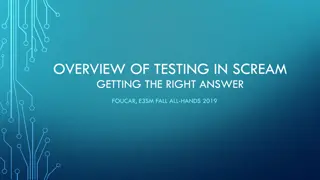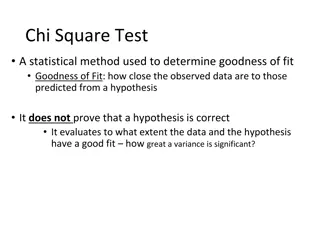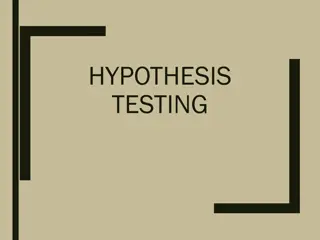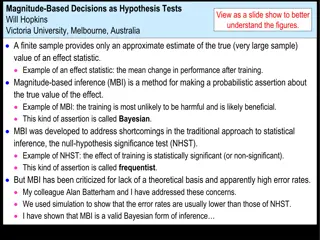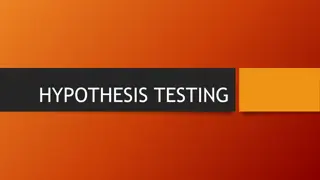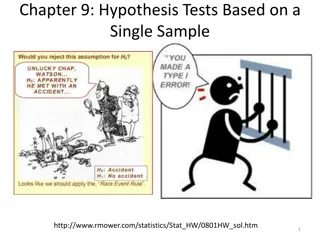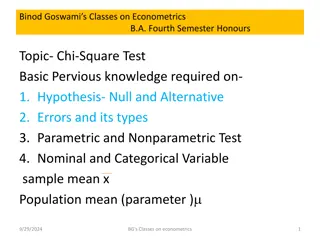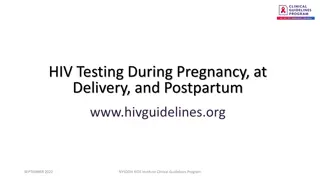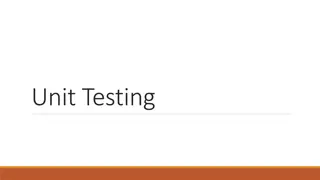Hypothesis testing
Explore hypothesis testing in statistics including the process of formulating null and alternative hypotheses, conducting tests, and interpreting results. See examples involving binomial distributions and multiple-choice testing. Understand the significance of critical regions and significance levels in hypothesis testing.
Download Presentation

Please find below an Image/Link to download the presentation.
The content on the website is provided AS IS for your information and personal use only. It may not be sold, licensed, or shared on other websites without obtaining consent from the author.If you encounter any issues during the download, it is possible that the publisher has removed the file from their server.
You are allowed to download the files provided on this website for personal or commercial use, subject to the condition that they are used lawfully. All files are the property of their respective owners.
The content on the website is provided AS IS for your information and personal use only. It may not be sold, licensed, or shared on other websites without obtaining consent from the author.
E N D
Presentation Transcript
Hypothesis testing BAT form null and alternative hypotheses for the Binomial Distribution BAT understand when to use one and two tailed tests and what is meant by a critical region and significance level KUS objectives Starter: ?~ ? ??, ?.? Find: ? ? ? ? ? ?? ? ? ? ?
Hypothesis testing Suppose that an anti-smoking campaign is held in a city. Before the campaign, health workers estimated that 30% of adults smoked cigarettes. Some time after the end of the campaign, a survey of 100 people (selected randomly) is conducted to find out if it has had any impact on reducing the number of smokers. 18 of people surveyed smoke If X~B(100, 0.3), ? ? ?? = ?.???? = ?.?% If the rate is still 30%, the result observed has a 4.5% chance of happening This could be classed as sufficient evidence that the rate has changed In a hypothesis test, population parameters (p for a Binomial Distribution) are tested against a given observation and possibly rejected as wrong. Null hypothesis Denoted by Ho, is the hypothesis assumed to be correct For eg above, H0: 0= 0.3 H1, tells us about the value of the population parameter if the assumed hypothesis assumed is shown to be wrong Alternative hypothesis For eg above, H1: p < 0.3
WB 1 Discuss: A student takes a multiple-choice test. There are 20 questions with 4 possible answers. Unfortunately the student has attended very few lessons so has to guess. The student gets 10 questions correct. The student claims to be an inspired guesser. Is this true? The ideal hypothesis test involves in this order: 1. Establish the null and alternative hypotheses 2. Decide on the significance level 3. Collect suitable data using a random sampling procedure that ensures the items are independent. 4. Conduct a test, doing the necessary calculations. 5. Interpret the results in terms of the original claim.
WB 1 continued A student takes a multiple-choice test. There are 20 questions with 4 possible answers. Unfortunately the student has attended very few lessons so has to guess. The student gets 10 questions correct. The student claims to be an inspired guesser. Is this true? We can follow the 5 steps of a hypothesis test 1. Establish the null and alternative hypotheses Let p be the mathematical probability the student guesses any question correctly Null Hypothesis ??:? =? Guesses one in four ? Alternative Hypothesis ??:? >? Guesses more than one in four ? 2. Decide on the significance level, lets say 5% 3. Collect suitable data the student gets 10 correct 4. Conduct a test, doing the necessary calculations. ?(? 10) = 0.0139 We will look at how this worked out later 5. Interpret the results 0.0139 is less than a 5% chance so REJECT ?0 The evidence suggests the student is an inspired guesser
WB 2 Discuss: The probability that a student at a certain school passes the Statistics exam is 0.8. A new teacher is appointed and takes the next group. Out of a group of 10 students only 6 students now pass. Should the Head of Maths be concerned? 1. Establish the null and alternative hypotheses Let p be the probability the student passes the statistics test The original pass rate ??:? = ?.? The pass rate has lowered ??:? < ?.? 2. Decide on the significance level, lets say 5% 3. Collect suitable data six out of ten students pass 4. Conduct a test, doing the necessary calculations. ?(? 6) = 0.1209 We will look at how this worked out later 5. Interpret the results 0.1209 is more than a 5% chance so DO NOT reject ?0 There is insufficient evidence that students are underperforming with the new teacher
WB 3 Significance and Critical regions John wants to see whether a coin is unbiased or biased towards heads. He tosses the coin 8 times and counts the number of heads. (X). a) Describe the test statistic b) Write a suitable null hypothesis and suitable alternative hypothesis a) Test statistic: The number of heads in 8 tosses b) ??:? = ?.? P(heads) is one half ??:? > ?.? biased towards heads If X is a random variable with values 0, 1, 2 , 8 and the coin is unbiased then we can work out the distribution of X c) Work out the distribution of X d) Find the critical region if the significance level is 5%
WB 3 continued If X is a random variable with values 0, 1, 2 , 8 and the coin is unbiased then we can work out the distribution of X X P(X=x) 0.0039 0.0312 0.1093 0.2187 0.2734 0.2187 0.1093 0.0312 0.0039 0 1 2 3 4 5 6 7 8 c) ?~ ? ?,?.? Use your calculator d) We have significance level 5% P(7 or 8) = 0.0312 + 0.0039 = 0.0351 = 3.5 % ] So X = 7, 8 would cause us to REJECT ?? Critical region 7 ? 8 Critical values X = 7, 8
WB 3 graphically Critical region
WB 4 Two tailed test An anti-smoking campaign is held in a city. Before the campaign, health workers estimated that 30% of adults smoked cigarettes. Some time after the end of the campaign, a survey is conducted to find out if it has had any impact on the number of smokers, positive or negative. A random sample of 10 adults is selected. a) Write a suitable null hypothesis and suitable alternative hypothesis b) State the distribution of X c) Find the critical region if the significance level is 5% a) ??:? = ?.? proportion smokers stays the same ??:? ?.? proportion smokers has changed b) Let X be the number of smokers. If ?? is true then we are using p = 0.3 and ? ~ ?(??, ?.?)
WB 4 continued If X is a random variable with values 0, 1, 2 , 8 and the coin is unbiased then we can work out the distribution of X X P(X=x) 0.0282 0.1210 0.2334 0.2668 0.2001 0.1029 0.0367 0.0090 0.0014 0.0001 0.0000 ] 0 1 2 3 4 5 6 7 8 9 c) ?~ ? ??,?.? Use your calculator d) We have significance level 10% 10% is 5% in each tail ?(? = 0) = 0.0282 = 2.8 % ] ] ] ?(6 ? 10) = 0.0472 = 4.7 % So X = 0, 6, 7, 8, 9 , 10 would cause us to REJECT ?? 10 Critical regions ? 0 and 6 ? 8 Critical values X = 0, 6, 7, 8, 9, 10
WB 4 graphically Critical region Critical region
Practice Ex 105A
KUS objectives BAT form null and alternative hypotheses for the Binomial Distribution BAT understand when to use one and two tailed tests and what is meant by a critical region and significance level self-assess One thing learned is One thing to improve is
